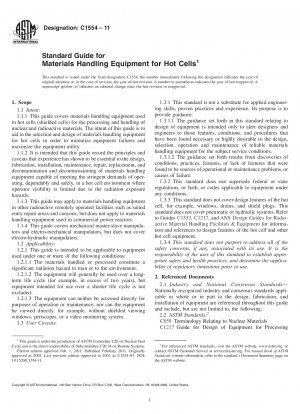ASTM C1554-11
Standard Guide for Materials Handling Equipment for Hot Cells
- Standard No.
- ASTM C1554-11
- Release Date
- 2011
- Published By
- American Society for Testing and Materials (ASTM)
- Status
- Replace By
- ASTM C1554-18
- Latest
- ASTM C1554-18(2023)
- Scope
Materials handling equipment operability and long-term integrity are concerns that originate during the design and fabrication sequences. Such concerns are most efficiently addressed during one or the other of these stages. Equipment operability and integrity can be compromised during handling and installation sequences. For this reason, the subject equipment should be handled and installed under closely controlled and supervised conditions.
This guide is intended as a supplement to other standards (Section 2, Referenced Documents), and to federal and state regulations, codes, and criteria applicable to the design of equipment intended for this use.
This guide is intended to be generic and to apply to a wide range of types and configurations of materials handling equipment.
The term materials handling equipment is used herein in a generic sense. It includes manipulators, cranes, carts or bogies, and special equipment for handling tools and material in hot cells.
This service imposes stringent requirements on the quality and the integrity of the equipment, as follows:
Boots and similar protective covers should not restrict movement of the equipment, should be properly sealed to the equipment and should withstand the radiation, cell atmosphere, dust, cell temperatures, chemical exposures, and cleaning and decontamination reagents, and also resist snags and tearing.
Materials handling equipment should be capable of withstanding rigorous chemical cleaning and decontamination procedures.
Materials handling equipment should be designed and fabricated to remain dimensionally stable throughout its life cycle.
Attention to fabrication tolerances is necessary to allow the proper fit-up between components for the proper installation and mounting of materials handling equipment in hot cells, for example, when parts or components are being replaced. Fabrication tolerances should be controlled to provide sufficiently loose fits where possible to aid in remote maintenance and replacement of equipment and components.
Fabrication materials should be resistant to radiation damage, or materials subject to such damage should be shielded or placed and attached so as to be readily replaceable.
Smooth surface finishes are necessary for decontamination reasons. Irregularities that hide and retain radioactive particulates or other adherent contamination should be eliminated or minimized.
Materials handling equipment that is exposed to high temperatures, pressures, acidic or caustic conditions may require special design considerations to be compatible with the operating environment. Potential rates of change for temperature and pressure as well as absolute temperature and pressure extremes, created by activation of fire suppression systems and other emergency systems, should be considered.
When replacing, modifying or adding additional materials handling equipment to an existing hot cell, maintenance records of materials handling equipment in that hot cell or in a hot cell having a similar processing mission may be available for reference. These records may offer valuable insight with regard to the causes, frequency, and type of failure experienced for the type and class of equipment being designed and engineered, so that improvements can be made in the new equipment.
Preventive maintenance based on previous experience in similar environments and similar duty should be performed to prevent unscheduled repair of failed components.
1.1 Intent:
1.1.1 This guide covers materials handling equipment used in hot cells (shielded cells) for the processing and handling of nuclear and radioactive materials. The intent of this guide is to aid in the selection and design of materials handling equipment for hot cells in order to minimize equ......
ASTM C1554-11 Referenced Document
- ASME NOG-1 Rules for Construction of Overhead and Gantry Cranes (Top Running Bridge, Multiple Girder)
- ASTM C1217 Standard Guide for Design of Equipment for Processing Nuclear and Radioactive Materials
- ASTM C1533 Standard Guide for General Design Considerations for Hot Cell Equipment
- ASTM C1572 Standard Guide for Dry Lead Glass and Oil-Filled Lead Glass Radiation Shielding Window Components for Remotely Operated Facilities
- ASTM C1615 Standard Guide for Mechanical Drive Systems for Remote Operation in Hot Cell Facilities
- ASTM C1661 Standard Guide for Viewing Systems for Remotely Operated Facilities
- ASTM C859 Standard Terminology Relating to Nuclear Materials
- ISO 9001 Quality management systems - Requirements [Spanish version]
ASTM C1554-11 history
- 2023 ASTM C1554-18(2023) Standard Guide for Materials Handling Equipment for Hot Cells
- 2018 ASTM C1554-18 Standard Guide for Materials Handling Equipment for Hot Cells
- 2011 ASTM C1554-11 Standard Guide for Materials Handling Equipment for Hot Cells
- 2003 ASTM C1554-03 Standard Guide for Materials Handling Equipment for Hot Cells
